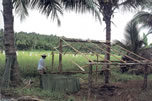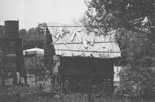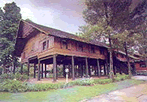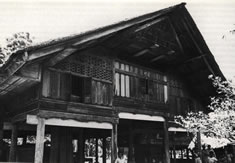



| builder's resource: |
    |
THE TRADITIONAL ACEHNESE HOUSE |
|---|
The traditional house of the Aceh Province is called Rumah Aceh. The Acehnese houses always face north or south. Along the peripheries of Banda Aceh, houses are usually compact wooden structures of a post-and-beam or H-structure, set ontop of flat, natural stones that are placed underneath each post. They are also known as “high houses” and are built onto tall posts to protect against animal attacks and flooding. No nails are used in the construction of Acehnese houses. Floors are made of wooden planks or rattan of feather palm; thin, interlaced sections of split bamboo or coconut leaves make up the walls, and sago palm leaves or corrugated iron cover the steeply pitched roofs. The house is divided into three sections:
|
 |
Symbolism was also incorporated into the design of an Acehnese house. The upper attic space represented the upper world or heaven, the middle living floor represented the middle world, and the bottom storage area represented the underworld. The main frame of the house is usually erected with aid of communal labor and supervised by the village elders, religious leaders, and a master builder. To begin, the site must be prepared and blessed. An Acehnese home owner is most likely to be a woman. In Achnese tradition, when a daughter is married, her father gives her a separate dwelling. If the family is too poor, an annex will be erected onto their house. |
MODERN ACEHNESE ARCHITECTURE |
|---|
Conscious efforts are made to take ventilation and sunlight into account. Ex. Placing a grid in front of a building façade to break up light and allow for optimum ventilation. Modern Aceh houses can may also me composed of: steel : concrete : make-shift shacks made out of found materials For more information regarding traditional and modern Acehnese architecture, link to : The House in Indonesia: Between Globalization and Localization http://www.leidenuniv.nl/fsw/nas/pub_houseIndonesia.htm |
SCARCE RESOURCES |
|---|
timber : Timber is an expensive building material in Indonesia. Due to the destruction of Indonesian rainforests over time, timber has become scarce, and not a viable construction material for the poorer villages of the Aceh province. The following species can be found in Sumatra. |
keruing or meranti [Dipterocarpaceae] :
 |
 |
 |
 |
 |
These massive trees with buttressing trunks can be found in the lowland forests of Sumatra. The light, hard wood is ideal for timber, and thus, has been overharvested. |
ironwood [Eusideroxylon zwageri] :
 |
 |
 |
 |
 |
The Ironwood tree is a slow growing tree, taking up to two hundred years to grow. Most of the Ironwood trees in Sumatra have been wiped out with its rainforests. Ironwood is very dense, hard wood, found in Sumatra and Borneo. Wealthy mansions and structures are often made of ironwood, but are not typically used in the construction of the typical Acehnese home. Most other forms of timber are scarce, expensive building materials in Indonesia. uses : floors : jetties : house posts : steps : walkways |
LOCAL BUILDING MATERIALS |
|---|
coconut tree :
 |
 |
 |
 |
 |
Coconut trees are an abundant resource in the Aceh Province, due to their adaption to sandy soils and coastal regions. Also known as the "tree of life," the entire tree proves to be useful in many respects. The coconut wood's strength is attributed to a high silica content. The wood is usually bathed in saltwater to increase its strength before its use as a building material. The densest portion of the wood would be well suite for door and window frames, and the portions of medium density could be used for window shutters, door, and wall panels. The fiberous husks surrounding the cocunut can be collected to make coir, which can make a variety of products including brushes and brooms, mats, ropes, bags, as well as an effective landscape fabric/mulch. Coconut shells can be converted into charcoal and used as an effective energy source. The carbonization of one ton of coconut shells can produce 130kg of charcoal. To learn more about the coconut tree products, link to: http://www.fao.org/documents/show_cdr.asp?url_file=/DOCREP/005/Y3612E/y3612e03.htm uses : houseposts : rafters : walls : windows : doors : framing : coal : roof covering : coal : etc. |
For more information related to coconut tree products and technology: "Coconut Husk and Coir Fibre Preliminary investigations carried out at the Central Building Research Institute at Roorkee and RRL Trivandrum, have shown that coconut husk and coir fibre combined with portland cement made a strong building panel and a corrugated roofing sheet. The panel can be used for both partitions and walling; its size and thickness would cut down on costs of the expensive timber work used with fibreboard and particle board. The corrugated sheet can be used for roofing after it has received a protective treatment against the effects of water and sun on the exterior facing. Coatings based on cashew nutshell liquid resin have shown excellent results in outdoor weather. On account of these properties, Coconut husk & fibre boards are produced and marketed in some cities of Southern India." http://www.bmtpc.org/pubs4 An article on wood substitutes using coconut fibre (India) "Coconut Husk and Coir Fibre Preliminary investigations carried out at the Central Building Research Institute at Roorkee and RRL Trivandrum, have shown that coconut husk and coir fibre combined with portland cement made a strong building panel and a corrugated roofing sheet. The panel can be used for both partitions and walling; its size and thickness would cut down on costs of the expensive timber work used with fibreboard and particle board. The corrugated sheet can be used for roofing after it has received a protective treatment against the effects of water and sun on the exterior facing. Coatings based on cashew nutshell liquid resin have shown excellent results in outdoor weather. On account of these properties, Coconut husk & fibre boards are produced and marketed in some cities of Southern India." http://www.cocofibres.com/en/research.html Uprooted coconut trees could erect new homes for cyclone victims http://www.sholay.com/stories/april2000/20042000.htm \Wonders from coco husk http://www.ias.unu.edu/proceedings/icibs/ic-mfa/jacob/paper.html REUSE OF BY-PRODUCTS IN COIR INDUSTRY: A CASE STUDY (India) http://www.inq7.net/nwsbrk/2002/aug/05/nbk_7-1.htm Facts on Coir: Lessons from the Past http://www.rolanka.com/index.asp?pg=coirarticle Vietnam introduces "eco-bricks" from coconut husk to world Vietnam has introduced "eco-bricks" made from the outer husk of coconuts at an international conference on coconut held recently in the Philippines under the sponsorship of the Asian Development Bank (ADB). The brick was invented a year ago and can substitute for wood in construction and arts. The new material has proved to be as strong as high-quality wood and humidity-proof, according to the evaluation conducted by the construction material service under the Southern Water Conservancy Institute. The product promises to be low-cost and environment friendly once it is mass-produced in southern Vietnam and other places of the world where vast areas of coconuts are grown. http://www.nhandan.org.vn/english/20030823/bai-eco1.html February 28th through March 1st 2002, a workshop on “Coir-based Building and Packaging Materials”, Wageningen, the Netherlands, was held. The three year project on “Coir-based Building and Packaging Materials”, is funded by the Common Fund for Commodities (CFC) and supervised by the Intergovernmental Group on Hard Fibres of the Food and Agricultural Organisation of the United Nations (FAO). The overall technical aim of the project is “the development of a cost-effective process for the processing of coconut husk into binderless building and packaging board material”. For further information, please contact: Ir. M.H.B. Snidjer m.h.b.snidjer@ato.wag-ur.nl and visit the website of ATO B.V. at www.ato.wageningen-ur.nl |
bamboo :
 |
 |
 |
 |
 |
Bamboo has rapidly become a popular building material, proving to be a much more sustainable alternative to wood, it is valued for its strengh and lightness. In comparison to the rigidity of steel or concrete, bamboo's high flexibility is well suited for earthquake prone areas. In Indonesia, it has proved to sustain storm and earthquake damage, however, its strength can be compromised with contact with wet soil and termites. It is a relatively strong material with a hard, clean surface, and can be easily cut with simple tools. Bamboo growth is fairly rapid, and is found throughout this region, making it an inexpensive alternative to timber, and can also be grown as a crop plant. Although bamboo is abundant in Sumatra, it is less so in the Aceh Province. uses : scaffolding/structural support : walls : roof material : flooring : infrastructure : and many others |
sago palm [Metroxylon sagu] :
 |
 |
 |
 |
 |
sago palm is a major source of thatch in Indonesia. In comparison to other forms of thatch, sago palm leaves have a longer lifespan, lasting up to seven years before replacement is necessary. uses : roofing material : thatch |
ALTERNATIVE BUILDING MATERIALS |
|---|
earthbag :
 |
 |
 |
 |
 |
Eathbag is a method of construction using plastic or textile casings (eathbags) packed with soil, and sometimes sand, gravel and cementitious materials. It can be used to construct foundations, walls, and domed structures. Earthbag is one of the most inexpensive building methods, and is very valuable to areas that are prone to flooding, hurricanes, or wildfires. Earthbag construction technique requires few skills, and if fastern than other earthbuilding methods. Architect Nader Khalili at Cal Earth in Hesperia has explored the use of earthbag construction both as residental houses and emergency shelters. Earthbag construction is a very pormising option for the rebuild in the Aceh area. For both temporary and permanent solutions. Emergency shelters made from sandbags and barbwire can be constructed in a few hours and have been proven to last for three winters. As a permanent solution, earthbag foundations could be built with arches which would allow water to pass through the first story. The living quarters above the earthbag foundation could be constructed out of bamboo and other materials more in the Acehnese traditional building style. Full residential, domed structures could also be constructed like those done by Nader Khalili. In the Aceh region, all of the other materials except for the bags can be found locally. Below is an approximate coast of what a 16ft corbled dome earthbag structure would cost. |
earthbag cost estimate : Profession backhoe excavation (2ft deep x 16ft diameter) $150 (optional could be done by hand) 40 tons of reject sand (delivered) 150 (probably could find these cheaper over there) 1,000 bags delivered (250) Homemade tools (compass, stands, pounders, etc.) 75 4-point barbed wire (2 rolls) 90 Plywood arch forms (reusable) 150 . Total: US$718(Note some materials made be subsitiuted with found materials to lessen price). |
|
|
Visit http://www.calearth.org/ for more information about Nader Khalili and earthbag.
recycled shipping containers :
|
The conversion of old shipping containers has become a new architectural design innovation. Openings are cut out for windows, and roofs are attached to create these structures which can be used as temporary and permanent homes, office, or commercial space. Shipping containers have also been converted as water purification or electrical generator stations, medical facilities, and of course, storage. The massive amount of food and medical supplies are being shipped to the country, and the reuse of these shipping containers as temporary emergency structures may prove to be a necessary and cost effective building material during this critical time. Check out these recent articles in shipping container construction: http://www.washingtonpost.com/wp-dyn/articles/A28394-2004May14.html http://www.archpaper.com/feature_articles/shipping_news.html This website links to articles and a slideshow of the construction of a shipping container school in Jamaica : |
OTHER MATERIALS TO CONSIDER :
mosquito netting : Sanitation and public health are critical matters in post-tsunami Indonesia, with a high risk of disease, it is important to maintain clean water sources, and protect from diseases such as malaria. The use of mosquito netting in disaster relief efforts can help maintain ventilation and protect against the spread of malaria by mosquitoes. There are also other ventilated materials on the market that are used specifically for temporary shelters. http://www.shelter-systems.com/shelters.html is one distrubutor of such products. woven ripstop film : It is a woven plastic laminate that is highly resistent to tear and allows for ventilation. A company by the name of Shelter Systems sells this woven covering for the construction of temporary shelters such as domes and tents. It also incorporates UV protection from the sun. http://www.shelter-systems.com/shelters.html INFRASTRUCTURE The majority of the Aceh Province is made up of poor villages, with little technology and minimal infrastructure. Indonesia is also known for being plagued with the most inferior system of infrastructure in South Asia. Electrical lines and clean water sources were destroyed by the tsunami, as well as roads, airports, and seaports. A simple irrigation system sustains the province's villages and their rice fields, which are composed of a series of canals and gabion weirs that divert water from the rivers and into the villages. |
other resources : |
|---|
|
Alternative Construction : Contemporary Natural Building Methods by Lynne Elizabeth and Cassandra Adams Traditional Architecture of Indonesia by Barry Dawson and John Gillow Indonesian Houses Edited by Reimar Schefold, Gaudenz Domenig and Peter Nas Living House: An Anthropology of Architecture in South-East Asia by Roxana Waterson Ecology of Sumatra by Anthony J. Whitten
|